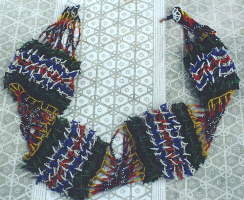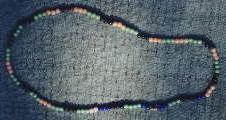
Click for image (83K)
As with most cultures, necklaces are a popular form of jewelery. It is also this type of garment that is most abundant in Zulu beadwork and the collection shows examples of this. Note that the coded language elements apply to all of the items. In general, the garments have specific social use, but the message is individual depending on the message the maker wanted to convey.
The simplest of the various types of necklace (generic term for necklaces in Zulu is imigexo, singular umgexo) is an umgexo_wamaqanda (literally "necklace of the eggs"). The large beads of which this necklace type is made, are called amaqanda (eggs), a Zulu symbol of fertility.

The Figure below shows a complex example of such an umgexo_wamaqanda, made up of several single strings gathered together like a wreath. Because of the significance of the large beads (amaqanda) of which these objects are made, they are worn only by women who have had children.

This garment is a cylindrical body of tightly rolled cloth covered in a sheath of beads in regional colours with typical male and female geometrical symbols. The object is called by several names:
It can be worn by males or females. Such cylinders, long enough to encircle the waist, are sometimes sown together to incorporate up to seven in a broad waistband called (as are most beaded belts without specific names) an umutsha.
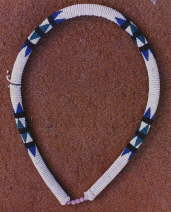
The graphic below shows several necklaces (we apologise for the out of focus picture). The top two white necklaces with the beaded squares are all amabheqe (common beaded gifts from a young girl to a favoured lover). Being all white, these emphasize virginity.
Top centre is a necklace with three differently coloured beaded sqaures on the same band (black, blue and black), called an umampapheni, usually worn by married women.
The other four objects are different kinds of imigexo (necklaces, singular umgexo, a generic name for necklaces).
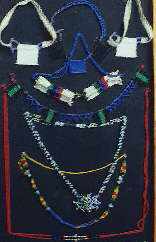
Another of the umgexo class, this necklace - with its diamond patterns - is for married women or for a girl formally engaged and soon to be married.

An interesting variation of the ibheqe-type of neck band, the two smaller ones featured at the top of this photograph are for young men who received them as gifts of favour. The girls presenting these articles wear the complimentary article, a larger version suspended from the neck and hanging like a pendant lower down upon the chest (bottom of picture). The other two objects are hollow beaded cylinders, purely decorative necklaces called amacimbi (Zulu for "caterpilars"), worn only by women.
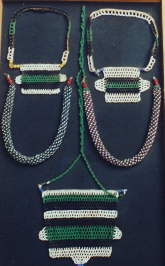
A classic example of a lover's gift from a girl to a man, called ibheqe. A personal message is often woven into the band, while conventional gender symbols form part of the design on the flap. These are commonly referred to in the tourist trade as "love letters" but in actual fact all traditional beadwork has some significance in male-female relationships.
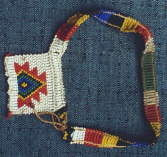
This 5-meter long strand of white beads has been twisted and doubled along its length as an indication of formal engagement, a relationship ratified by the families of the parties concerned. A single-stranded version of the same object is worn only on the day the girl accepts the overtures of the young man, who then has to inform his family so that negotiations can begin. It is a sign of acceptance valid only within the peer group of the two individuals and is worn for only one day. It is then put away until negotiations are complete, when its is taken out and twisted into the form illustrated here. Both forms are called ucu.
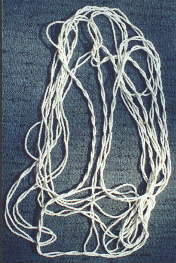
Top: A large beaded square on which appears the diamond pattern of the married woman, suspended from the neck by a lacework neckband of beads so that it reaches the upper part of the chest like a beaded pendant. It is called ineba, which also appears in other, more simplified forms.
At bottom is a beaded belt (umutsha) to which is attached a decorative beaded apron called isinene when worn by males and isigege when used by females.
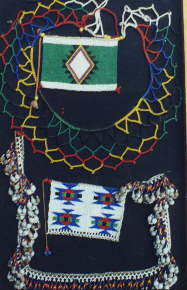
The two objects shown below are called ujiza, complimentary forms of the same thing with a function much like the ucu shown earlier. These signify the acceptance of a young man by a girl, and in the one with three crossbars a formally ratified engagement in which the relationship has the consent of both families.
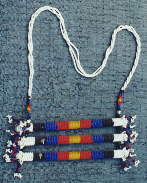
This is an indawana, a young unmarried male's necklace, worn when visiting girls in courtship.
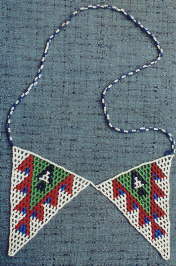
This is a beautiful example of a modern beaded necklace, showing excellent workmanship and using traditional symbols as part of its decorative design. It is worn by married women.
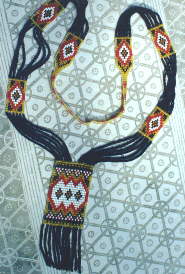
A remarkable feat of beaded craft, this object - called an isihlahla - is a large hollow beaded tube, divided into a number of segments which are connected to each other with strings of beads. Into these complete, often very poetic messages are woven. It is a massive necklace-like article, worn around the neck like a garland and used only on the wedding day of a couple, each of which wears an identical example. It is worn only on that day and afterwards dismantled so that the beads can be used for something else.
See them being modelled by a girl here (73K).
